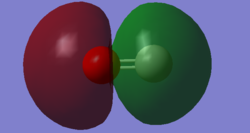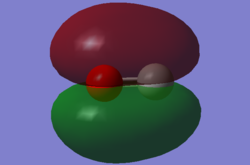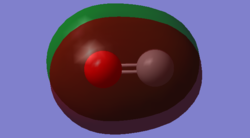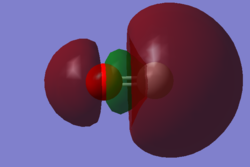Rep:Mod:01527432
NH3
optimisation
| Calculation Method | RB3LYP |
| Basis Set | 6-31G(d,p) |
| E(RB3LYP) | -56.55776873 a.u. |
| RMS Gradient Norm | 0.00000485 a.u. |
| Point Group | C3V |
| bond length | 1.02 Å |
| bond angle | 106 ° |
Item Value Threshold Converged? Maximum Force 0.000004 0.000450 YES RMS Force 0.000004 0.000300 YES Maximum Displacement 0.000072 0.001800 YES RMS Displacement 0.000035 0.001200 YES
test molecule |
The optimisation file is linked to here
frequency analysis
| wavenumber/cm-1 | 1090 | 1694 | 1694 | 3461 | 3590 | 3590 |
| symmetry | E | A1 | A1 | E | A1 | A1 |
| intensity | 145 | 14 | 14 | 1 | 0 | 0 |
| graph | 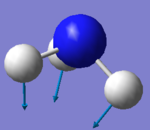 |
 |
 |
 |
 |

|
| number of vibrational modes from 3N-6 rule | 3 |
| degenerate modes/cm-1 | 1694, 3590 |
| bending/cm-1 | 1694,1090 |
| bond stretch/cm-1 | 3461,3590 |
| highly symmetric mode/cm-1 | 3461 |
| 'umbrella' mode/cm-1 | 1090 |
| number of bands in an experimental spectrum of gaseous ammonia | 2 |
atomic charge
| charge on the N atom | -1.125 |
| charge on the H atoms | +0.375 |
| expected charge on the N atom | -3 |
| expected charge on the H atoms | +1 |
The negative charge on N atom is because of the higher electronegativity on N.
N2
crystal structure
(dinitrogen)-{2,2',2-(phosphanetriyl)tris[1-(diphenylphosphanyl)-3-methyl-1H-indole]}-ruthenium tetrahydrofuran solvate
refcode:DEKFUX
structure: the CCDC database[1]
N-N computational distance= 1.10550 Å
equivalent distance in the structure=1.086(6) Å
reasons: The bond length in crystal structure is lower than that of the N2 molecule. IR spectroscopy reveals that the formation of a coordinated dinitrogen ligand is weakly activated. Bond length should decrease with the increase of frequency. It could be because of steric hindrance that force the bond to be shorter.
reaction energies
| E(NH3) | -56.55777 a.u. |
| 2*E(NH3) | -113.11554 a.u. |
| E(N2) | -109.52413 a.u. |
| E(H2) | -1.17854 a.u. |
| 3*E(H2) | -3.53562 a.u. |
| ΔE=2*E(NH3)-[E(N2)+3*E(H2)] | -146.5 kJ mol-1 |
The product NH3 is favoured since this is an exothermic reaction with lower energy for products.
CO
optimisation
| Calculation Method | RB3LYP |
| Basis Set | 6-31G(d,p) |
| E(RB3LYP) | -113.30945314 a.u. |
| RMS Gradient Norm | 0.00001828 a.u. |
| Point Group | C∞V |
bond length = 1.14 Å
4 CO molecule C 0.0000 0.0000 -0.6502 O 0.0000 0.0000 0.4877
Item Value Threshold Converged? Maximum Force 0.000032 0.000450 YES RMS Force 0.000032 0.000300 YES Maximum Displacement 0.000012 0.001800 YES RMS Displacement 0.000018 0.001200 YES
jmol files
test molecule |
The optimisation file is liked to here
frequency analysis
frequency analysis
| wavenumber/cm-1 | 2209 |
| symmetry | SG |
| intensity | 68 |
atomic charge
| charge on the O atom | -0.506 |
| charge on the C atoms | +0.586 |
| expected charge on the O atom | -1 |
| expected charge on the C atom | +1 |
The negative charge on O is because of the higher electronegativity of O.
crystal structure
tetracarbonyl-[methylenebis(diphenylphosphane)]-tungsten
refcode:CEMSAP
structure: the CCDC database
C-O computational distance= 1.14 Å
equivalent distance in the structure=1.15 Å
reaction energies
2CO + O2 -> 2CO2
| E(CO) | -113.30945 a.u. |
| 2*E(CO) | -226.61890 a.u. |
| E(O2) | -150.25251 a.u. |
| E(CO2) | -188.58094 a.u. |
| 2*E(CO2) | -377.16188 a.u. |
| ΔE=2*E(CO2)-(2*E(CO)+E(O2)) | -762.6 kJ mol-1 |
The product CO2 is favoured since this is an exoothermic reaction with lower energy for products.
MO
Since the energy of the 2s of C and the 2p of O is close to each other, the new σ orbitals are also close to each other in terms of energy, and so do the new σ* orbitals. Hence, s-p mixing should be considered when dealing with the molecular orbitals.
References
- ↑ F. F. van de Watering, J. I. van der Vlugt, W. I. Dzik, B. de Bruin, J. N. H. Reek, Chem. Eur. J. 2017, 23, 12709.
Marking
Note: All grades and comments are provisional and subject to change until your grades are officially returned via blackboard. Please do not contact anyone about anything to do with the marking of this lab until you have received your grade from blackboard.
Important comment: As you have not shown you finished the part about N2 and H2 by uploading the corresponding .log files, we cannot mark the the sections regarding the crystal structure and the Hamer-Bosch reaction energy.
Wiki structure and presentation 0.5/1
Is your wiki page clear and easy to follow, with consistent formatting?
YES
Do you effectively use tables, figures and subheadings to communicate your work?
YES - however, all your jmols are labelled 'test molecule' which is not informative at all.
NH3 1/1
Have you completed the calculation and given a link to the file?
YES
Have you included summary and item tables in your wiki?
YES
Have you included a 3d jmol file or an image of the finished structure?
YES
Have you included the bond lengths and angles asked for?
YES
Have you included the “display vibrations” table?
YES
Have you added a table to your wiki listing the wavenumber and intensity of each vibration?
YES
Did you do the optional extra of adding images of the vibrations?
YES
Have you included answers to the questions about vibrations and charges in the lab script?
YES
N2 and H2 0/0.5
Have you completed the calculations and included all relevant information? (summary, item table, structural information, jmol image, vibrations and charges)
NO
Crystal structure comparison 0/0.5
Have you included a link to a structure from the CCDC that includes a coordinated N2 or H2 molecule?
YES
Have you compared your optimised bond distance to the crystal structure bond distance?
YES
Haber-Bosch reaction energy calculation 0/1
Have you correctly calculated the energies asked for? ΔE=2*E(NH3)-[E(N2)+3*E(H2)]
YES
Have you reported your answers to the correct number of decimal places?
YES
Do your energies have the correct +/- sign?
YES
Have you answered the question, Identify which is more stable the gaseous reactants or the ammonia product?
YES
Your choice of small molecule 4/5
Have you completed the calculation and included all relevant information?
YES - You could have discussed the computed vibration mode in more detail as you did for NH3.
Have you added information about MOs and charges on atoms?
YES - You missed to discuss which influence the MOs have on bonding as well as to explain the relative order in terms of energy (e.g. number of nodes).
Independence 0.5/1
If you have finished everything else and have spare time in the lab you could: Check one of your results against the literature, or Do an extra calculation on another small molecule, or Do some deeper analysis on your results so far
You have included a reaction energy for the conversion of CO to CO2 and a crystal structure of a complex binding to CO - these are great ideas! However, the information on the complex is minimal and no discussion has followed the stated data. We cannot take into account the calculation of the reaction energy as no .log file for a O2 optimisation and frequency analysis has been linked to.

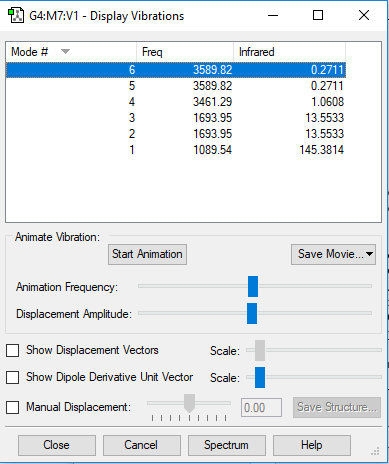
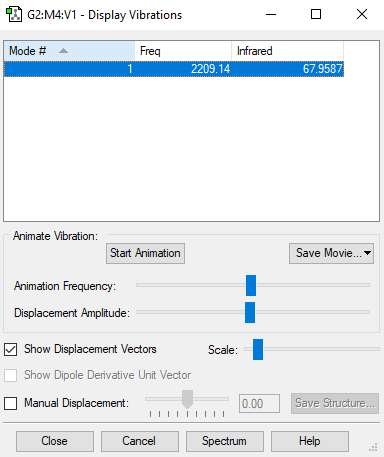
![The IR spectrum of CO]](/images/thumb/8/80/Spectrum.PNG/550px-Spectrum.PNG)
